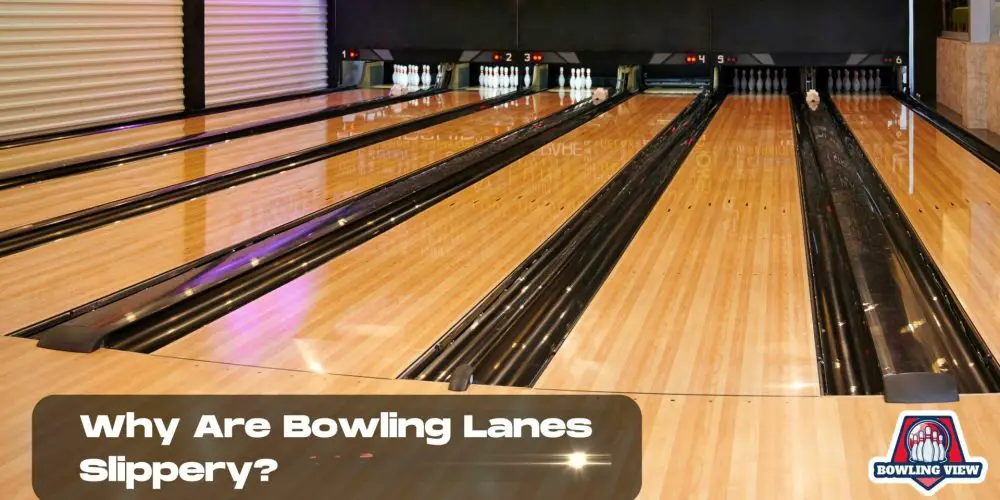Why are bowling lanes slippery? It’s a question that many newcomers to the sport ask. Bowling, enjoyed by millions worldwide, is as much a science as it is a game. A central aspect that puzzles beginners and fascinates professionals alike is the unique characteristic of the bowling lanes: their deliberate slipperiness.
This slipperiness is no accident, but a finely orchestrated element of the game, affecting everything from the roll of the ball to the strategy of the players.
This blog aims to delve into the reasons behind this slipperiness, the role of oiling in maintaining it, and how understanding this can help improve your game.
Understanding Bowling Lanes
Before we delve into the specifics of why bowling lanes are slippery, it’s crucial to understand their anatomy. A standard bowling lane measures approximately 60 feet (18.29 meters) in length from the foul line to the headpin, and about 41.5 inches (1.05 meters) wide. Each lane is composed of 39 boards, each approximately 1.25 inches wide.
Typically, the materials used for bowling lanes are either wood or synthetic. Traditional wooden lanes are typically made from hard rock maple and pine, with maple being used for the approach, pin deck, and the first 12 feet of the lane, and pine for the rest.
Synthetic lanes, on the other hand, are usually composed of compressed paper or particle board covered with a high-density laminate. Both types of lanes are designed for durability and to provide certain gameplay characteristics.
Why Bowling Lanes Are Slippery?
Bowling lanes are slippery due to the presence of oil, which is intentionally applied to the lane surface. This application of oil, known as “lane conditioning,” serves several essential purposes.
First, it protects the lane surface from damage caused by the continual impact of bowling balls. Second, it influences the ball’s trajectory as it travels down the lane, adding an additional level of complexity and skill to the game.
The process of lane conditioning involves applying oil to the lane in a specific pattern using a lane oiling machine.
The oil is typically applied more heavily on the center of the lane and less on the outer edges, creating what is often referred to as an “oil pattern.” These patterns can vary in complexity from a basic, uniform layer of oil across the lane to intricate shapes and designs intended to challenge experienced bowlers.
The oil decreases friction between the ball and the lane, affecting the ball’s spin and direction, and making the game more challenging and unpredictable. Understanding the concept of lane conditioning is critical for bowlers as it influences their strategy and approach to the game.
Types of Lane Conditions
There are generally two types of lane conditions that bowlers encounter: the “house pattern” and the “sport pattern”. The house pattern, typically used in casual play and local leagues, features a high concentration of oil in the middle of the lane and less on the outsides.
This creates a predictable, easy-to-navigate path for the ball. On the other hand, the sport pattern, used in professional competitions, has a more even distribution of oil across the lane, making it significantly more difficult to control the ball’s trajectory.
Explanation of Different Lane Oil Patterns
Lane oil patterns can vary greatly in complexity. A basic pattern might involve a uniform layer of oil across the lane, but more complex patterns can include various shapes and designs, with oil applied more heavily in certain areas than others.
For example, the “Christmas Tree” pattern features a series of triangles, each one smaller than the last, starting from the foul line and ending at the pins.
How Oil Patterns Affect the Game
The oil pattern on a lane significantly influences the game, affecting the ball’s spin, speed, and direction. A ball thrown down a heavily oiled part of the lane will skid more and hook less, while a ball thrown on a drier part of the lane will hook more.
Understanding the oil pattern allows bowlers to adjust their throwing technique and choose the most effective line to the pocket. Therefore, reading the oil pattern accurately and adjusting accordingly is a crucial skill for any serious bowler.
Maintaining Bowling Lanes
Maintaining bowling lanes is a meticulous process that plays a crucial role in the game’s integrity. This process begins with cleaning the lanes using specialized equipment to remove the dirt, grime, and residue left by bowling balls. Once the lanes are thoroughly cleaned, lane oil is applied evenly across the surface.
The process of oiling the lanes is more than just a random task; it requires a well-calculated approach. The oil is often applied in patterns, which can drastically affect how the ball moves on the lane. The types and amount of oil used, along with the specific pattern, are determined by various factors including the type of bowling event and the playing level of the bowlers.
As technology advances, so does the equipment used for lane maintenance. Modern lane machines use sophisticated computer systems to control the application of the oil, allowing for a high degree of precision and consistency.
This high level of control allows for the creation of complex oil patterns, providing a wide range of lane conditions to challenge bowlers of all skill levels. These advancements in lane maintenance technology have not only improved the quality of play but have also added a new layer of strategic depth to the game of bowling.
How to Adjust to Slippery Lanes
Bowlers may often find themselves on a slippery lane, a situation that requires certain adjustments to ensure an optimal performance.
One of the best strategies is to shift your starting position slightly to the left (for right-handed bowlers) or to the right (for left-handed bowlers). This change alters the angle of the ball’s trajectory, enabling it to gain more traction before reaching the slippery part of the lane.
Tips for Bowlers to Adapt to Different Lane Conditions
Adapting to various lane conditions is a vital skill for any bowler. Observing the ball’s behavior and adjusting your throw accordingly is a vital first step. For instance, if your ball is hooking too early, you might need to move your feet and target to the right. Conversely, if it’s hooking too late, adjust left.
Moreover, changing your ball speed can also be an effective strategy to cope with different conditions. A slower speed gives the ball more time to hook, while a faster speed reduces the hook.
Equipment Considerations for Different Oil Patterns
The equipment, specifically the bowling ball, plays a significant role in adapting to different oil patterns. Balls with a lower surface friction (shinier balls) are ideal for heavy oil conditions as they slide through the oil more readily, saving their hook for the end of the lane.
In contrast, balls with a higher surface friction (matte finish balls) are better suited for lighter oil conditions as they generate more friction with the lane surface, enabling them to hook earlier.
The choice of the right equipment, coupled with the right techniques, can greatly improve a bowler’s performance across various lane conditions.
Conclusion
In conclusion, understanding and adapting to various bowling lane conditions is a crucial aspect of improving one’s bowling skills. This includes observing and adjusting one’s throw based on the ball’s behavior, modifying ball speed, and choosing the appropriate equipment, specifically the bowling ball, based on the oil pattern.
A shinier ball with lower surface friction is recommended for heavy oil conditions, while a matte finish ball with higher surface friction is more suited for lighter oil conditions. By mastering these strategies, bowlers can effectively adapt to different lane conditions, ultimately enhancing their overall performance and proficiency in the game.
Understanding lane conditions not only equips bowlers with the necessary skills to tackle varying circumstances, but it also adds a strategic depth to the game that elevates bowling from a simple sport to an art form.
Frequently Asked Questions – Why Are Bowling Lanes Slippery?
Bowling is a sport of precision and technique where the conditions of play can significantly impact the game.
One common question, especially from newcomers and those striving to improve their game, revolves around the characteristics of the playing surface: “Why are bowling lanes slippery?” Let’s explore the answer to this frequently asked question.
1. Why are bowling lanes slippery?
Bowling lanes are slippery to facilitate the movement of the bowling ball. The slick surface allows the ball to roll smoothly across the lane, which is essential for a successful bowling game.
2. How is the slipperiness of bowling lanes achieved?
Bowling lanes are coated with a layer of oil, commonly known as the lane oil or oil pattern. This oil is applied to the lane to help the ball glide effortlessly. The amount of oil and its pattern can vary based on different factors.
3. What is the purpose of oil on the bowling lanes?
The oil on the bowling lanes serves multiple purposes. Firstly, it helps create a uniform playing surface by protecting the lane from wear and tear caused by the heavy bowling balls. Secondly, it affects the ball’s trajectory and helps control the ball’s movement. Lastly, it also adds an element of challenge and strategy to the game.
4. How does the oil pattern affect the ball’s behavior?
The oil pattern on the bowling lanes can greatly influence the ball’s path. Different oil patterns can make the lanes more or less slippery in different areas. The ball tends to slide more on the oiled sections, and hook or grip better on the drier sections. This affects how the ball hooks and ultimately how the bowler should adjust their technique and aim.
5. Who applies the oil to the bowling lanes?
The application of oil to the bowling lanes is usually done by the bowling alley staff. They are responsible for maintaining and adjusting the oil patterns based on the specific requirements or preferences of the bowlers or the bowling center.
6. How is the amount of oil applied to the lane determined?
The amount of oil applied to the lane can vary depending on factors such as lane conditions, level of play, and the preference of the bowlers. Some bowlers might prefer less oil to allow for more hook, while others might prefer more oil for a smoother ball motion.
7. Are there different types of oil patterns used on bowling lanes?
Yes, there are various types of oil patterns used on bowling lanes. The professional bowling association, for example, has established a set of standard oil patterns for tournaments. These patterns can vary in length, volume, and distribution of oil across the lane.


